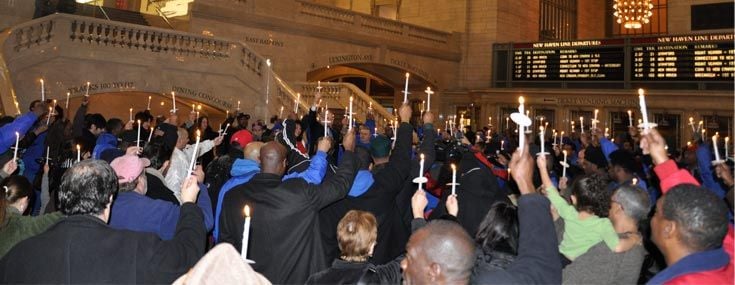
Newsroom
| < Return To News Archive | |
| August 16, 2004 | |
| Trying to Clean Up New York | |
by Gail Robinson | |
Ridley and Negron, who both served time in jail, participate in the Doe Fund's Ready, Willing and Able for homeless people and former convicts. It is part of the patchwork of government and private programs that try to keep New York clean. Despite such efforts, New York does not seem to have shaken its long-time reputation for being filthy: In a poll in 2002, almost half the visitors to New York (and more than half of New Yorkers themselves) said that the city's streets were dirty. This is not the way it has to be in a big city. "The biggest difference between New York and Paris is the fact that Paris is clean," David Garrard Lowe wrote in City Journal in 1996. Every morning, Parisian merchants hose sidewalks, and city machines spray streets and remove litter from under parked cars. "The fact that Paris is clean gives Parisians a sense that things are not falling apart," said Lowe, "that society is not doomed, that there is order in the universe and municipal government." New York City has struggled over the past decades to overcome its reputation. Now, says the Bloomberg administration, it has largely succeeded. A recent city survey (in pdf format) found 89 percent of city streets "acceptably clean" -- a higher percentage than at any time since the city began keeping records 30 years ago. But the cleanliness of the city remains a heated political issue, as a recent furor over debris on city beaches makes clear. Critics doubt whether the city really is as clean as the administration claims. And they question whether the city can claim responsibility for any improvement there has been. Private groups, such as neighborhood and civic organizations, play an increasing role in sanitation, picking up trash, bagging garbage, and cleaning up graffiti (see related stories on Kew Gardens Hills and Riverdale.) Does the city rely too much on such groups? Or should it turn even more over to private agencies? CLEAN STREETS, HEALTHY STREETS On one fact everybody can agree: The city is certainly cleaner than it was for much of its history. That is not difficult. For centuries the filth of New York streets was legendary, over-the-top, deadly. Efforts to clean it up had little effect, starting with the law banning the disposal of animal carcasses and other garbage in city streets in 1657. In the 19th century, residents dumped their garbage directly onto the street, attracting foraging dogs and pigs. By the end of the century, some 2.5 million tons of horse manure fell in city streets every single day. "Before 1895 the streets were almost universally in a filthy state," wrote George Waring, the man credited with improving the situation. "Rubbish of all kinds, garbage, and ashes lay neglected in the streets, and in the hot weather the city stank with the emanations of putrefying organic matter. It was not always possible to see the pavement, because of the dirt that covered it." The city established the Department of Sanitation in 1881, but it remained mired in corruption. The situation came to a head when the blizzard of 1888 dumped 21 inches of snow on the city. Snow removal was haphazard at best, and once the snow melted, the city still had to take care of the garbage, including several hundred animal carcasses. Several years later, Waring was named commissioner of the Department of Street Cleaning. He organized the department as though it was an army, cracked down on patronage and gave street sweepers white uniforms, leading to the nickname "whitewings." Two years later Waring would boast: "New York is now thoroughly clean in every part. . . ." "Clean streets means much more than the casual observer is apt to think. It has justly been said that 'cleanliness is catching,'and clean streets are leading to clean hallways and stair cases and cleaner living-rooms." But as New Yorkers know, the city had not won the battle. Since the mayor's office began issuing ratings on street cleanliness in 1975, the results have fluctuated widely. In 1980, only 53 percent of the streets were considered "acceptably clean." Ratings improved steadily until they reached the low 70s in 1986 and remained there until the late 1990s. But that was not clean enough. Garbage-strewn vacant lots and filthy streets blighted many neighborhoods. "New York is surely the filthiest of any major American city, the only one that does not have a single faultlessly kept area under city control," Julia Vitullo Martin wrote in City Journal in 1993. But by the end of the decade, things had improved. Many areas seemed cleaner, and the rating rose to above 80 percent, where it remains today. HOW CLEAN IS CLEAN? To reach its findings on street cleanliness, the mayor's office of operations rates selected streets and sidewalks on a scale (in pdf format) from 1.0 (no litter) to 3.0 (litter is highly concentrated). But the method is not totally scientific, giving the mayor's political opponents the opportunity to question the findings. The results of the most recent report card "seem like Alice in Wonderland," Councilmember Christine Quinn, whose district includes Greenwich Village and Chelsea, told the New York Post. "The number one complaint I hear -- I'm not exaggerating it -- at every block association meeting is dirty streets and litter." This summer's biggest clash over cleanl | |
| < Return To News Archive | ^ back to top |